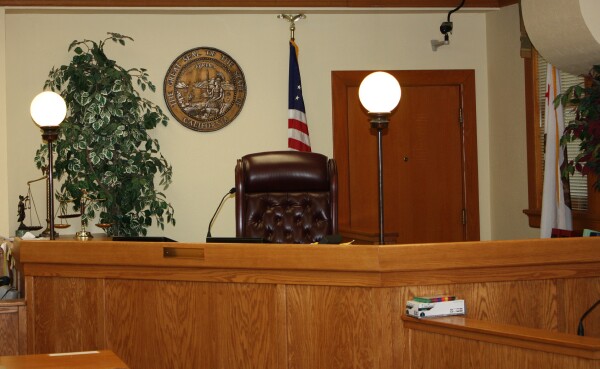
Over the first portion of the year 2011, we have often noted the sea-change that has occurred in Yolo County with regard to the results of jury trials. Some readers have asked for statistical analysis to bolster these claims.
In 2010, 112 jury trials were litigated county-wide. The Yolo County Public Defender’s Office was attorney of record in 75% of the trials. That overstates their presence somewhat, as a number of those are multi-defendant cases and the Public Defender’s office would only represent one individual in such a case.
Nevertheless, the numbers are stark and revealing. In 2011, from January through July, the Yolo County Public Defender’s Office was attorney of record during 56 jury trials, 39 of which were felony trials.
They gained outright acquittals in 18 of those trials, including 12 acquittals in felony trials.
In another 15 cases, including 14 felony trials, they ended up beating the pre-trial offer. This is not insignificant, as it suggests that the DA overestimated the strength of their case in addition to overcharging the case.
In six of those instances, the jury hung on the verdict, two were settled as misdemeanors, and three resulted in significantly reduced prison time. One individual was convicted of only a misdemeanor with a not guilty and a hang on the felonies, and the DA chose to dismiss the hung felony.
There were four felony cases that resulted in guilty verdicts, but the sentence imposed by the court beat the DA’s pre-trial offer. The defendant got probation instead of prison which the DA had offered, and one got a misdemeanor rather than a felony.
There were also 15 trials that resulted in worse outcomes than the offer, including seven in felony trials.
Overall, the acquittal rate still seems very low at 32%, 31% in felony trials. Certainly, compared to jurisdictions like San Francisco, that represents a low number. However, it nearly doubled the rate from 2010 when just 15 of 112 jury trials resulted in acquittals or dismissals (18%).
Another way to look at it, though, is not the outright acquittal rate, but rather the estimation of the trial. We can think of it this way, the defense has a viewpoint; the prosecution has a viewpoint. The jury is the decider of facts.
In 18 of the 56 cases, the jury ruled completely in favor of the defendant. In 15 cases, the jury ruled completely in favor of the prosecution. The rest of the time, however, it is a gray area.
In 59% of cases, the defense benefited from going to trial this year. In 67% of felony cases, the defense beat the offer, which can be seen as the prosecution’s estimation of the strength of their case, by going to trial.
Moreover, in 28 of 39 felony cases (72%), the defense did no worse by going to trial.
By way of comparison, those numbers are far higher than they were in previous years.
In 2010, as we mentioned, the acquittal rate was only 18%, but they have already had more acquittals (18) in 2011 through July than they had all of 2010 (15). Moreover, the defense benefited by going to trials only a third of the time in 2010, and in 2011 it is double that, at around 66% in felony trials.
But, as we have reported in the past, Yolo County has one of the highest imprisonment rates in the state, which indicates that traditionally Yolo County has a much higher conviction rate than other counties, since the overall crime rate is lower.
Is the change this year due to particulars in Yolo County, or is something more happening?
One week in the end of July, five people in Yolo County were acquitted by juries, another person the jury hung on, and a seventh person was convicted but only after acquittal on the most serious charge.
At the time we argued that something is changing. We noted that we have seen in the past much weaker prosecution cases end in convictions than the ones we saw that week.
The public seems less likely to convict people of more minor crimes this year than in the past.
In July, we saw Rodney Snow, an alleged member of the Vagos Motorcycle Gang, acquitted on three counts of possession of a firearm, despite the fact that they found the weapon in the car wrapped in a shirt he had been wearing earlier in the day, and one officer testified that he had confessed to possessing the weapon.
However, there were some mistakes. The officer acknowledged lying to Mr. Snow, attempting to get him to confess, they found no fingerprints on the weapon, and they failed to record the interview.
Earlier this year, Maria Olivares was acquitted of possession of heroin and meth for sale and transporting less than 28 grams of marijuana. The evidence turned on the fact that there were two phones in the car and neither the prosecution nor the police bothered to check with the phone company to determine whose phones they were.
In the end, she was acquitted, in part because of discrepancies between a video and the testimony of police officers.
At the time, we noted that, while we lack the official statistics, the number of cases that have resulted in outright acquittals have soared over what we saw last year.
These numbers now bear that out.
At the state level, we have seen a number of factors come into play. There has been a prolonged public campaign arguing that we spend too much money incarcerating what are perceived to be less than the most egregious and dangerous crimes.
In May, the US Supreme Court upheld a California court’s ruling that ordered the state to find ways to reduce the state’s overflowing prison population. The state is currently paying $9.8 billion on the prison system alone.
And what are people getting for that money? California has the highest recidivism rate in the country, despite a string of draconian measures such as three strikes, that puts people in prison for increasingly long terms.
The voters have started to express concern over costs. According to one poll, over 60% of voters in California favor reducing sentences for “third-strike” cases that involve property crimes or other non-violent crimes. Another 69% favor releasing individuals convicted of low-level non-violent offenses from prison at earlier dates. Both Republicans and Democrats agree in large numbers that the state should not be cutting government services in education and healthcare in order to pay for prisons.
Still another poll from earlier this year found that 72% of Californians supported reclassifying low-level possession of drugs from a felony to a misdemeanor.
Voters are even turning away from the death penalty, as they see billions going into a system that has only executed 13 individuals since 1978.
Despite these changes, we still see problems. The Yolo County DA continues to expend resources to capture people who are far less than dangerous. A recent case involving the Kalah family illustrates the fundamental waste of resources.
The police and Prosecutor Ryan Couzens had conducted six months of surveillance on the property. However, when they raided it, there were pills that turned out to be caffeine pills, powder that turned out to be Ibuprofen, and 1.4 grams of meth.
After weeks of trial, the judge dismissed charges against Det Kalah, and Saengphet Onsri was convicted on charges that will likely result in 7 to 12 years in prison for in essence possessing 1.4 grams of meth for sale, and there were two hung juries.
Mr. Onsri conceded the possession of meth, but claimed he was personally selling it to make ends meet. Dom and Anthony Kalah would take plea agreements rather than face sentences similar to Mr. Onsri’s.
Was that a good use of police and DA resources? Ryan Couzens, charged by the defense attorneys with wasting public resources, shot back.
In his closing statement, Mr. Couzens even acknowledged that this was a small-time operation but he called it a gang, selling drugs, despite really a complete lack of evidence that this was anything other than Mr. Onsri selling drugs.
He admitted that he is very aggressive about gangs and crimes. He said the same for his office. He admitted that they did not find evidence of a huge drug operation – that they only found 1.4 grams of meth.
But he said that if we allow “specks of methamphetamine” to go unchecked, if we allow a fledgling gang to go unchecked, just because it is a fledgling operation, that “that’s throwing in the towel.”
He said that it is irrelevant that Sacramento or Stockton would charge this crime as a misdemeanor. He said that it is on them, and their problem. He said this is Yolo County and we do things differently here.
But what Mr. Couzens is ignoring is that the people of Yolo County may be turning against this very policy that many people consider to be overcharging. And so, perhaps because of this attitude, as embodied in the words of Mr. Couzens that probably spoke more truth than the DA’s office would have liked, we see Mr. Snow acquitted on gun charges and others acquitted on drug charges.
We launched Yolo Judicial Watch back in January of 2010 with a mission that puts people into the courtrooms to evaluate and watch what occurs. In regular articles we have noted a number of problems that are fairly systemic – and not just to Yolo County. But Yolo County, as the statistics bear out, remains among the worst culprits.
In two-thirds of cases this year, juries believed that the facts of the case did not support the magnitude of charges put on by the District Attorney’s office. That does not include cases such as Nang Sam, in which the outcome was clearly in error (and the verdict and outcome in Nang Sam is not on the jury).
—David M. Greenwald reporting





[quote]While we do not have the full array of statistics from Yolo County court trials, we do have those from the Public Defender’s office. [/quote]
As you say, you don’t have the full array of stats, just that of the Public Defender’s Office.
[quote]Overall, the acquittal rate still seems very low at 32%, 31% in felony trials. Certainly, compared to jurisdictions like San Francisco, that represents a low number. However, it nearly doubled the rate from 2010 when just 15 of 112 jury trials resulted in acquittals or dismissals (18%).[/quote]
I’m a bit confused here. Are you conceding that the acquittal rate in Yolo is lower than that of San Francisco and other jurisdictions? If yes, why do you think that is?
[quote]In 18 of the 56 cases, the jury ruled completely in favor of the defendant. In 15 cases, the jury ruled completely in favor of the prosecution. The rest of the time, however, it is a gray area.[/quote]
So where’s the beef?
[quote]But, as we have reported in the past, Yolo County has one of the highest imprisonment rates in the state, which indicates that traditionally Yolo County has a much higher conviction rate than other counties, since the overall crime rate is lower.[/quote]
Some voters would see this as the DA doing a very good job…
[quote]And what are people getting for that money? California has the highest recidivism rate in the country, despite a string of draconian measures such as three strikes, that puts people in prison for increasingly long terms.[/quote]
So let’s reform the 3 strikes law…
[quote]In regular articles we have noted a number of problems that are fairly systemic – and not just to Yolo County.[/quote]
Exactly.
If my memory serves, you’ve also bemoaned the supposed increase in cases that go to trial instead of ending up in plea bargains. Your stats here would suggest that is not a real concern (112 in 2010 vs. 56 in the first 7 months of 2011). Am I reading this correctly?
With respect to your primary statistical point, I’m pleased to see that the public defender is doing a much better job–both in knowing “when to hold ’em…when to fold ’em” in plea negotiations as well as in defending clients who then go to trial. Give them some credit! [quote][i]”That does not include cases such as Nang Sam, in which the outcome was clearly in error (and the verdict and outcome in Nang Sam is not on the jury).[/i][/quote]The verdict “is not on the jury”–the jury is just as responsible for guilty decisions as well as not guilty findings. I’m not sure why you mentioned the Sam case here, since it clearly outside the period of available statistics.
“As you say, you don’t have the full array of stats, just that of the Public Defender’s Office. “
So what? They represent about 75% of the cases, that’s a good sample.
“Are you conceding that the acquittal rate in Yolo is lower than that of San Francisco and other jurisdictions?”
I’m not conceding, that’s been part of the point for some time.
“So where’s the beef? “
Why does there have to be a beef?
“Some voters would see this as the DA doing a very good job… “
Some wouldn’t.
“So let’s reform the 3 strikes law… “
Agreed.
“Exactly. “
So let’s not change what we do in Yolo because everyone else does it too. Got it.
“If my memory serves, you’ve also bemoaned the supposed increase in cases that go to trial instead of ending up in plea bargains. Your stats here would suggest that is not a real concern (112 in 2010 vs. 56 in the first 7 months of 2011). Am I reading this correctly? “
Yes but you are missing the point that the jump did not occur from 2010 to 2011. In 2011, the level is staying about the same. The jump occurred a few years earlier when it doubled. It used to be 56 was about the number we had in a full year.
“I’m not sure why you mentioned the Sam case here, since it clearly outside the period of available statistics. “
Just an example of cases that would not be noted in the statistics even if they fell within the time period.
[quote]So let’s not change what we do in Yolo because everyone else does it too. Got it. [/quote]
No, that is not what I meant. Let’s not single out and blame Yolo for what is a systemic problem in the legal system…
I don’t think that’s what has happened. What i view this as is a court watch program, where we report what is happening in Yolo. We also talk about some of the more global issues in the justice system and apply them to Yolo. However, there clearly are cases where Yolo is more extreme than other counties, they admit it, they charge minor cases more stringently than other counties. I hear all the time that Yolo County often charges as a felony what other counties charge as a misdemeanor. Up until this year, the juries were fairly conservative and convicted people at a higher rate than other counties and put them into prison at a higher rate. That has changed somewhat this year.